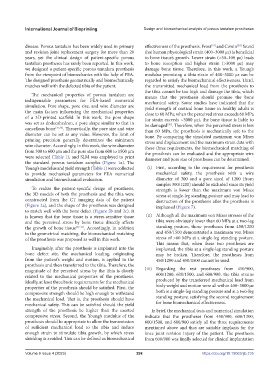Page 306 - IJB-9-4
P. 306
International Journal of Bioprinting Design and biomechanical analysis of porous tantalum prostheses
disease. Porous tantalum has been widely used in primary effectiveness of the prosthesis. Frost and Cowin found
[20]
[19]
and revision joint replacement surgery for more than 20 that human physiological strain (400–3000 με) is beneficial
years, yet the clinical design of patient-specific porous to bone tissue’s growth. Lower strain (<50–100 με) leads
tantalum prostheses has rarely been reported. In this work, to bone resorption and higher strain (>3000 με) may
we designed a patient-specific porous tantalum prosthesis damage bone tissue. Therefore, in this work, a Young’s
from the viewpoint of biomechanics with the help of FEA. modulus promising a tibia strain of 400–3000 με can be
The designed prosthesis geometrically and biomechanically regarded to satisfy the biomechanical effectiveness. Third,
matches well with the defected tibia of the patient. the transmitted mechanical load from the prosthesis to
the tibia cannot be too high and damage the tibia, which
The mechanical properties of porous tantalum are means that the prosthesis should promise the bone
indispensable parameters for FEA-based numerical mechanical safety. Some studies have indicated that the
simulation. Pore shape, pore size, and wire diameter are yield strength of cortical bone tissue in healthy adults is
the main factors influencing the mechanical properties close to 60 MPa; when the perceived stress exceeds 60 MPa
of a 3D-printed scaffold. In this work, the pore shape (or strain exceeds ~3000 με), the bone tissue is liable to
was set as dodecahedron, a pore shape similar to that in be damaged . Therefore, when the perceived stress is less
[20]
cancellous bone [37,38] . Theoretically, the pore size and wire than 60 MPa, the prosthesis is mechanically safe to the
diameter can be set as any value. However, the limit of bone. By comparing the simulated maximum von Mises
printing precision generally determines the minimum stress and displacement and the maximum strain data with
wire diameter. Accordingly, in this work, the wire diameter these three requirements, the biomechanical matching of
from 300 to 600 μm and the pore size from 600 to 1500 μm the prosthesis can be evaluated and the appropriate wire
were selected (Table 1), and SLM was employed to print diameter and pore size of prostheses can be determined.
the standard porous tantalum samples (Figure 1a). The
Young’s modulus and yield strength (Table 1) were collected (i) First, according to the requirement for prosthesis
to provide mechanical parameters for FEA numerical mechanical safety, the prosthesis with a wire
simulation and biomechanical evaluation. diameter of 300 and a pore sized of 1200 (from
samples 300/1200) should be excluded since its yield
To realize the patient-specific design of prosthesis, strength is lower than the maximum von Mises
the 3D models of both the prosthesis and the tibia were stress at single-leg standing posture and may lead to
constructed from the CT imaging data of the patient destruction of the prosthesis after the prosthesis is
(Figure 2a), and the shape of the prosthesis was designed implanted (Figure 7).
to match well with the bone defect (Figure 2b and 2c). It
is known that the bone tissue is a stress-sensitive tissue (ii) Although all the maximum von Mises stresses of the
and the perceived stress by bone tissue directly affects tibia were obviously lower than 60 MPa at a two-leg
the growth of bone tissue [39-43] . Accordingly, in addition standing posture, those prostheses from 450/1200
to the geometrical matching, the biomechanical matching and 450/1500 demonstrated a maximum von Mises
of the prosthesis was proposed as well in this work. stress of >60 MPa at a single-leg standing posture.
This means that, when these two prostheses are
Imaginably, after the prosthesis is implanted into the implanted, the tibia at a single-leg standing posture
bone defect site, the mechanical loading, originating may be broken. Therefore, the prostheses from
from the patient’s weight and motion, is applied to the 450/1200 and 450/1500 cannot be used.
prosthesis and then transferred to the tibia. Therefore, the
magnitude of the perceived stress by the tibia is closely (iii) Regarding the rest prostheses from 450/900,
related to the mechanical properties of the prosthesis. 600/1200, 600/1500, and 600/900, the tibia strains
Ideally, at least three basic requirements for the mechanical produced by the transferred mechanical load from
properties of the prosthesis should be satisfied. First, the body weight and motion were all within 400–3000 με
compressive strength should be high enough to withstand both at a single-leg standing posture and at a two-leg
the mechanical load. That is, the prosthesis should have standing posture, satisfying the second requirement
mechanical safety. This can be satisfied should the yield for bone biomechanical effectiveness.
strength of the prosthesis be higher than the exerted In brief, the mechanical tests and numerical simulation
compressive stress. Second, the Young’s modulus of the indicate that the prostheses from 450/900, 600/1200,
prosthesis should be appropriate to allow the transmission 600/1500, and 600/900 satisfy all the three requirements
of sufficient mechanical load to the tibia and induce mentioned above and thus are suitable implants for the
enough strain to stimulate tibia growth, by which stress knee joint revision injury of the patient. The prosthesis
shielding is avoided. This can be defined as biomechanical from 600/900 was finally selected for clinical implantation
Volume 9 Issue 4 (2023) 298 https://doi.org/10.18063/ijb.735

